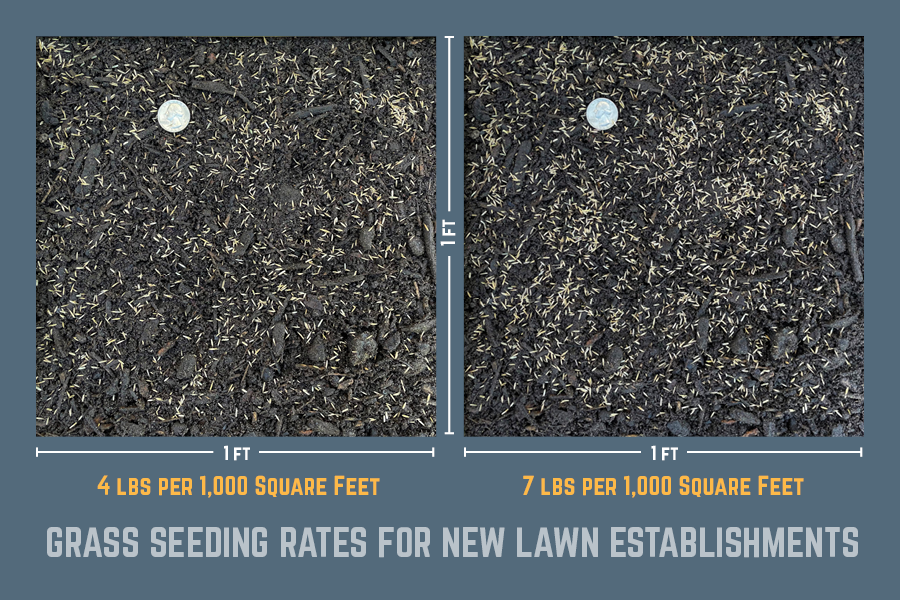Seeding your lawn can be a rewarding experience, promising verdant green carpets that enhance your outdoor space. However, overseeding, the accidental application of too much grass seed, can lead to unsightly clumps and hinder healthy lawn growth. Fortunately, there are effective methods to rectify this situation and restore the lushness of your lawn. Embark on this comprehensive guide to learn how to handle excessive grass seed and achieve a thriving, pristine lawn.

Image: oursweetgarden.com
Understanding Overseeding: Causes and Impacts
Overseeding commonly occurs when homeowners apply more grass seed than recommended per square foot. Overenthusiasm, wind, or uneven distribution can contribute to this issue. Excessive seed density leads to competition among grass seedlings for sunlight, nutrients, and moisture, resulting in uneven growth, patchy areas, and weak overall turf.
Remedies for Overseeding: Restoring Your Lawn’s Health
Addressing overseeding requires a multi-faceted approach to restore your lawn’s balance and vitality. Follow these steps for effective remediation:
1. Brush and Remove Excess Seed
Gently brush the lawn with a soft-bristled broom or leaf rake to loosen and remove the excess seed. This step helps eliminate the overcrowding issue, allowing existing seedlings to develop healthily.

Image: atonce.com
2. Water Deeply to Wash Away Seeds
Thoroughly water your lawn after brushing to further wash away the excess seed. Ensure deep watering to penetrate the soil and remove any remaining seed.
3. Thinning Out Seedlings: Encouraging Optimal Growth
Once the new grass seedlings emerge, it may be necessary to thin them out to achieve optimal growth. Carefully remove excess seedlings, gently pulling them out or using a handheld tool. This step allows the remaining seedlings to spread out and establish stronger root systems.
4. Aeration and Fertilization: Improving Soil Health
Aerating the lawn can address soil compaction caused by overseeding. This promotes proper root development and nutrient absorption. Subsequently, fertilize the lawn to provide necessary nutrients for healthy growth.
5. Evaluate and Repeat as Needed
Monitor your lawn’s progress regularly. If concerns persist, repeat the brushing or thinning process as needed. Patience is key as lawns recover and establish healthy growth over time.
Preventing Overseeding: Best Practices for Lawn Seeding
To avoid overseeding and potential lawn health issues, adhere to these best practices:
1. Determine Seeding Rate: Follow Package Instructions
Carefully read the instructions on the grass seed package to determine the recommended seeding rate per square foot. Follow these guidelines precisely to prevent excessive seed application.
2. Use a Spreader: Ensures Even Distribution
A seed spreader ensures an even distribution of seed across your lawn, minimizing the risk of overseeding. Set the spreader to the appropriate setting based on the seed package instructions.
3. Overlap Passes Slightly: Avoid Missed Areas
When using a seed spreader, slightly overlap each pass to avoid missing areas. This ensures a uniform coverage without excessive seed application.
4. Check Lawn Regularly: Monitor Seedling Growth
Regularly monitor your lawn’s progress after seeding to identify any potential overseeding issues promptly. This allows for early intervention to prevent long-term lawn health concerns.
How To Fix Too Much Grass Seed
Conclusion
Overseeding can be remedied with the proper care and attention. By following the techniques outlined in this guide, you can restore the lushness of your lawn and prevent future overseeding issues. Remember to adhere to best practices for lawn seeding to maintain a healthy and visually appealing outdoor space. The rewards of a well-manicured lawn will provide lasting enjoyment and enhance your home’s curb appeal.
Additional resources and professional guidance can assist you in maintaining a healthy lawn. Consult with gardening experts or reputable landscapers for personalized advice and tailored solutions for your specific lawn care needs. Embrace the joy of a thriving, verdant lawn, a testament to your green thumb and outdoor landscaping efforts.